Like small signposts, these curious organisms can tell us a lot about the air we’re breathing.
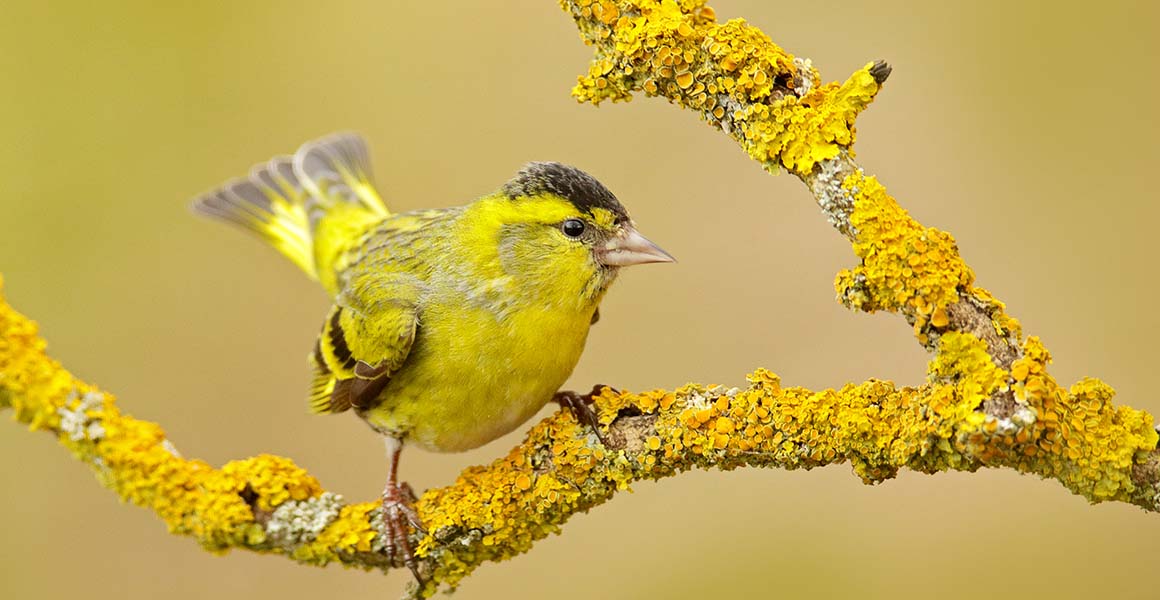
Lichens can tell us a lot about air pollution and ecosystems. © Ondrej Prosicky/ Shutterstock
Fresh, clean air is wonderful to breathe in. Without the health risks of air pollution, fresh air feels great for our lungs.
Lichens love clean air too – in fact, their sensitivity to air pollution means they make good air quality indicators.
Lichens can tell us the effects of air pollution on ecosystems, not just of the number of pollution particles in the air. This is handy if you want to know how air pollution is changing ecological communities and what that means for the people who rely on them.
If you don’t yet know what lichens look like, once you start searching you might see them everywhere, even in the unlikeliest of places.
What are lichens?
Lichens are miniature ecosystems made of fungus and an algae and/or cyanobacteria. These different life forms work so closely together that the algae or cyanobacteria actually sits inside the fungus. The algae or cyanobacteria provide the fungus with sugars made from sunlight, and the fungus provides the home.
Lichens look like spots or clumps of colour, like someone has splashed paint onto a branch of a tree. Their colours range from green to brown to white to russet red. Even in these colours, lichens can be understated additions to tree trunks and rocks, and you might miss them at first glance.
There are many types of lichen but they only grow in three ways. They can be branched like tiny shrubs, they can have crinkly little leaves or they can grow like a crust on a surface.
Our lichen identification guide will help you look for and find different types of lichen in your area.
Feeling sensitive: lichens and air pollution
To grow, lichens get their nutrients from the air. Because lichens have no roots or protective surface, they can’t filter what they absorb, so anything in the air is taken straight inside. If there are pollutants, they can accumulate in the lichen and can become toxic very quickly.
Our lichens expert Gothamie Weerakoon says that they make great air pollution indicators. “Lichens are very sensitive and respond to pollution in short time frames,” she explains.
Butterflies, nematodes, frogs and toads are also very good indicators of environmental pollutants, but lichens are easier to study and are quicker to respond to environmental change.
Next time you’re on a walk, look around to see what types of lichen are growing in your area. Generally, the less variety and the smaller the size of lichens in an area, the more polluted it is.
Two main air pollutants that affect lichen growth are nitrogen and sulphur dioxide.
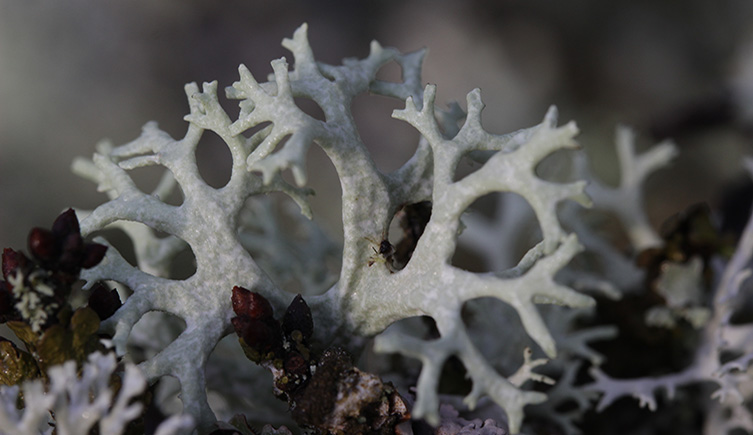
The oakmoss lichen is sensitive to nitrogen in the air. This beardy lichen can be found on woodland branches where the air is clean. Image © Björn S via Wikimedia Commons, licensed under CC BY-SA 2.0
Some lichens thrive in nitrogen pollution
We breathe in harmless nitrogen gas all the time – in fact it makes up a large part of Earth’s atmosphere. But when nitrogen is heated and combined with oxygen – as it is in a car engine – nitrogen oxides are created.
Nitrogen dioxide in the air can be a powerful polluter and becomes harmful for human health in high concentrations. In UK cities, around half the nitrogen dioxide air pollution comes from road traffic. Farms also emit nitrogen pollutants from fertilisers, farm machinery and livestock waste.
Nitrogen dioxide gas can inflame the lining of the lungs and can cause respiratory symptoms such as shortness of breath and a cough. Nitrogen dioxide can also decrease your body’s immune response to lung infections. For people with asthma, nitrogen dioxide air pollution may mean more frequent attacks.
Some lichens will die in the presence of nitrogen, while others will thrive. By learning a few common lichen species, you can judge the nitrogen pollution levels in your area.
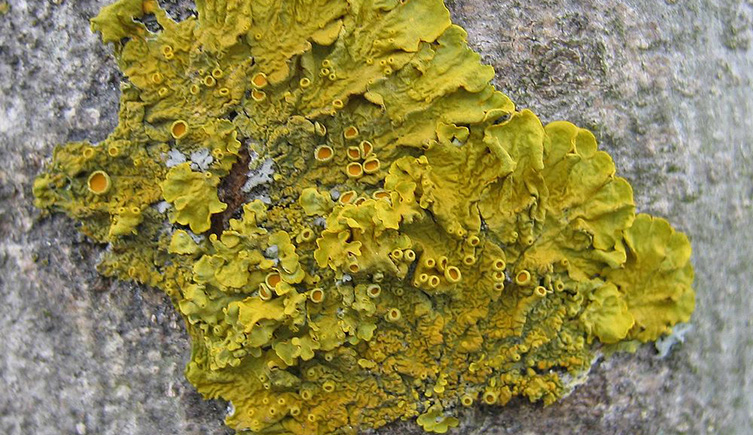
Not all lichens are sensitive to air pollution – crustier lichens tend to be hardier than the hairy lichens. The golden shield lichen, Xanthoria parietina, can live in areas with high levels of nitrogen, especially ammonia. It’s common on trees and buildings near farmland and on sea cliffs where seabirds’ droppings provide nitrogen. Image © Tigerente via Wikimedia Commons, licensed via CC BY-SA 3.0
Lichens and sulphur dioxide pollution
Sulphur dioxide pollution comes from coal burning and industry. This pollutant has killed many lichens around the UK in the past, but now because we burn less coal, they’re beginning to return.
In high concentrations, sulphur dioxide can irritate the mucus lining of the eyes, nose, throat and lungs. Exposure to sulphur dioxide may cause coughing and tightness in your chest. People with asthma are more sensitive to sulphur dioxide pollution.
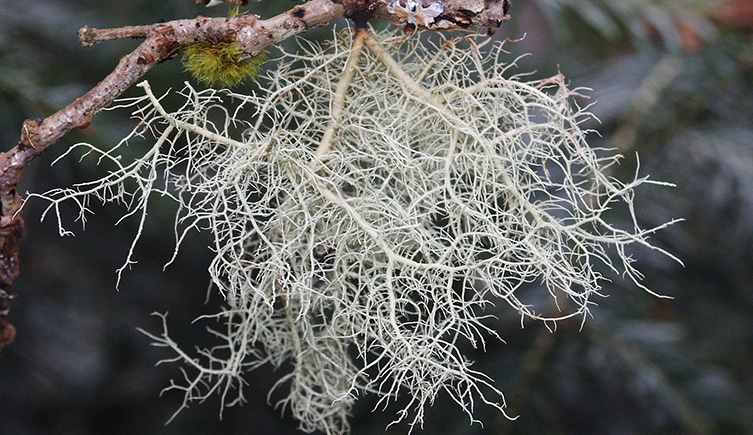
Usnea lichens, also called old man’s beard, don’t grow in areas where there’s sulphur dioxide pollution. If you see one of these on your walk, it means that coal probably hasn’t been burnt in the area for some time. Image © Bernd Haynold via Wikimedia Commons, licensed via CC BY 3.0
You can find out more about surveying lichens to assess air pollution as part of an earlier Open Air Laboratories (OPAL) citizen science project that mapped lichens in the UK.
Antibiotics, perfumes and incense
Humans have many uses for lichens, including as a source of potential antibiotic, anti-fungal and anti-cancer drugs. Lichens can also be used in perfumes and incense and as a clothes dye.
Lichens are important for other plants and animals too. They’re able to grow in some barren places, such as on the surface of a rock. When the lichens break down, they leave behind organic material that other things can grow in.
Lichens are also food for many animals, including reindeer, squirrels, snails and insects.
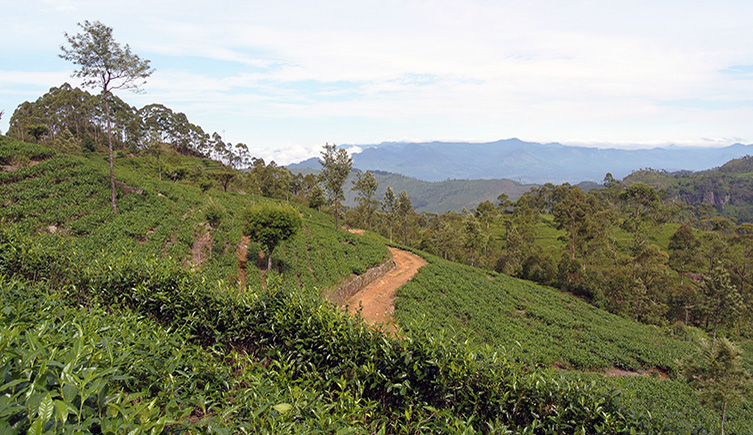
Can studying lichens tell us how fertilisers used on tea plantations are affecting surrounding ecosystems? Image © Adbar via Wikimedia Commons, licensed under CC BY-SA 3.0
Our work: can lichens tell us if growing tea is changing cloud forests?
Our researchers are part of a global team investigating nitrogen pollution from tea estates in Sri Lanka and in the forests of the Himalayas.
Tea growers in Sri Lanka use fertilisers that contain nitrogen in the form of ammonia. This ammonia does not stay on the tea farm, and some of it inevitably flows into the surrounding ecosystems.
The nitrogen is carried into the atmosphere through winds and sits in the clouds, ready to rain on the nearby mountains and cloud forests.
“Every year the amount of nitrogen increases in the atmosphere, from the increase of fertilisers being used,” says Gothamie.
Gothamie is part of a team that has set up monitoring plots in Sri Lanka to measure the effects of nitrogen air pollution, using lichens as indicators.
These plots sit high up in the mountain cloud forests, and the researchers have been recording how the lichen community in these plots change over time.
When setting up the experiment, they considered the local climate and known atmospheric nitrogen levels. They then released nitrogen in a controlled way onto the plots to test the effects of different nitrogen concentrations.
Analysis of this data is now underway. The research will help us understand how increases in fertiliser use on tea farms affect ecosystems in South Asia.
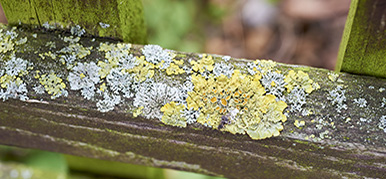
Find out more about lichens
Need help with identification? Read our guide to lichens.

Find Your Climate Action
Taking small, actionable steps can have a big impact when it comes to helping the planet.
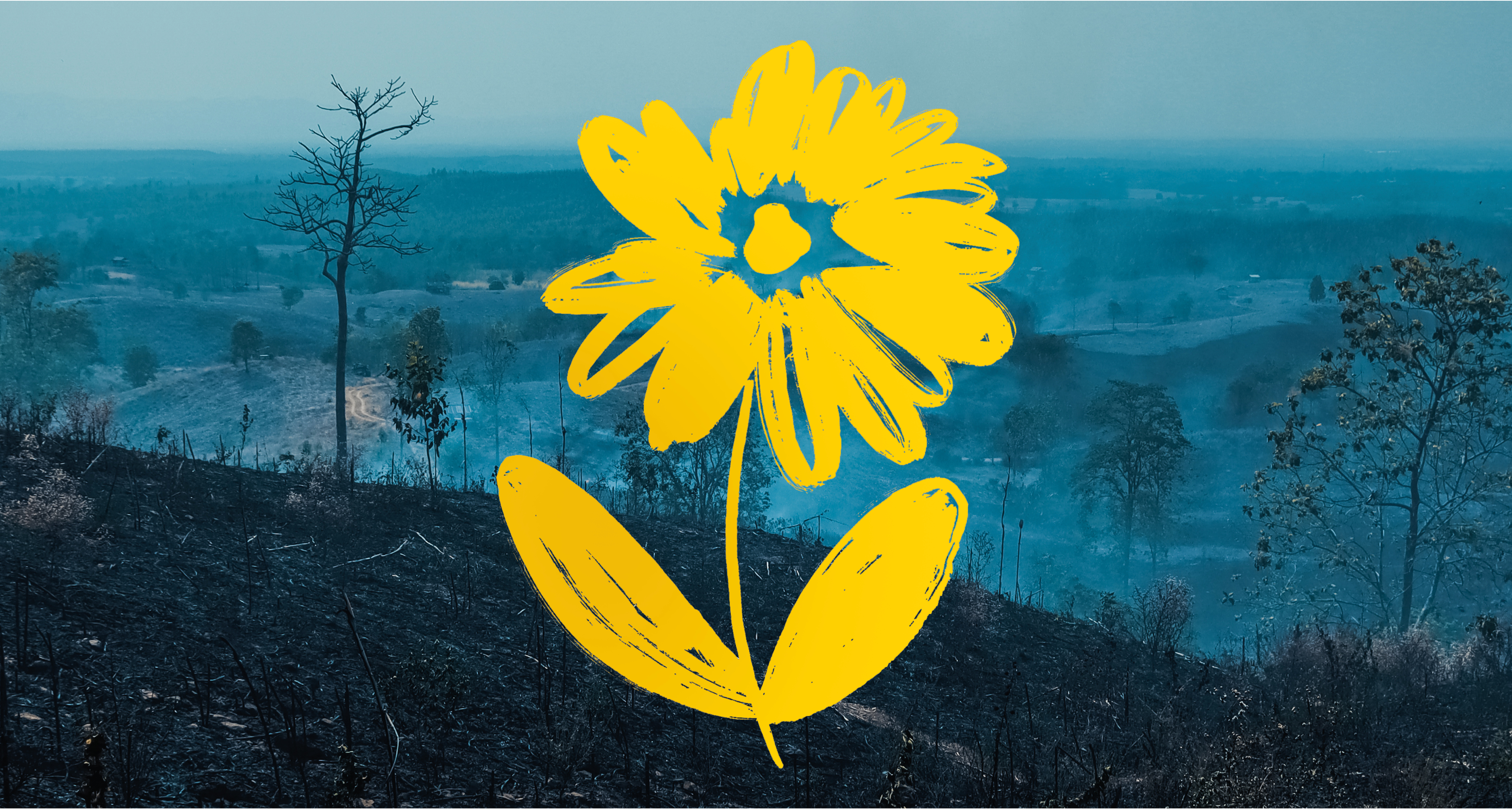
Fixing Our Broken Planet
Discover science-backed, hopeful solutions that will help us to create a more sustainable world.
New gallery open now.

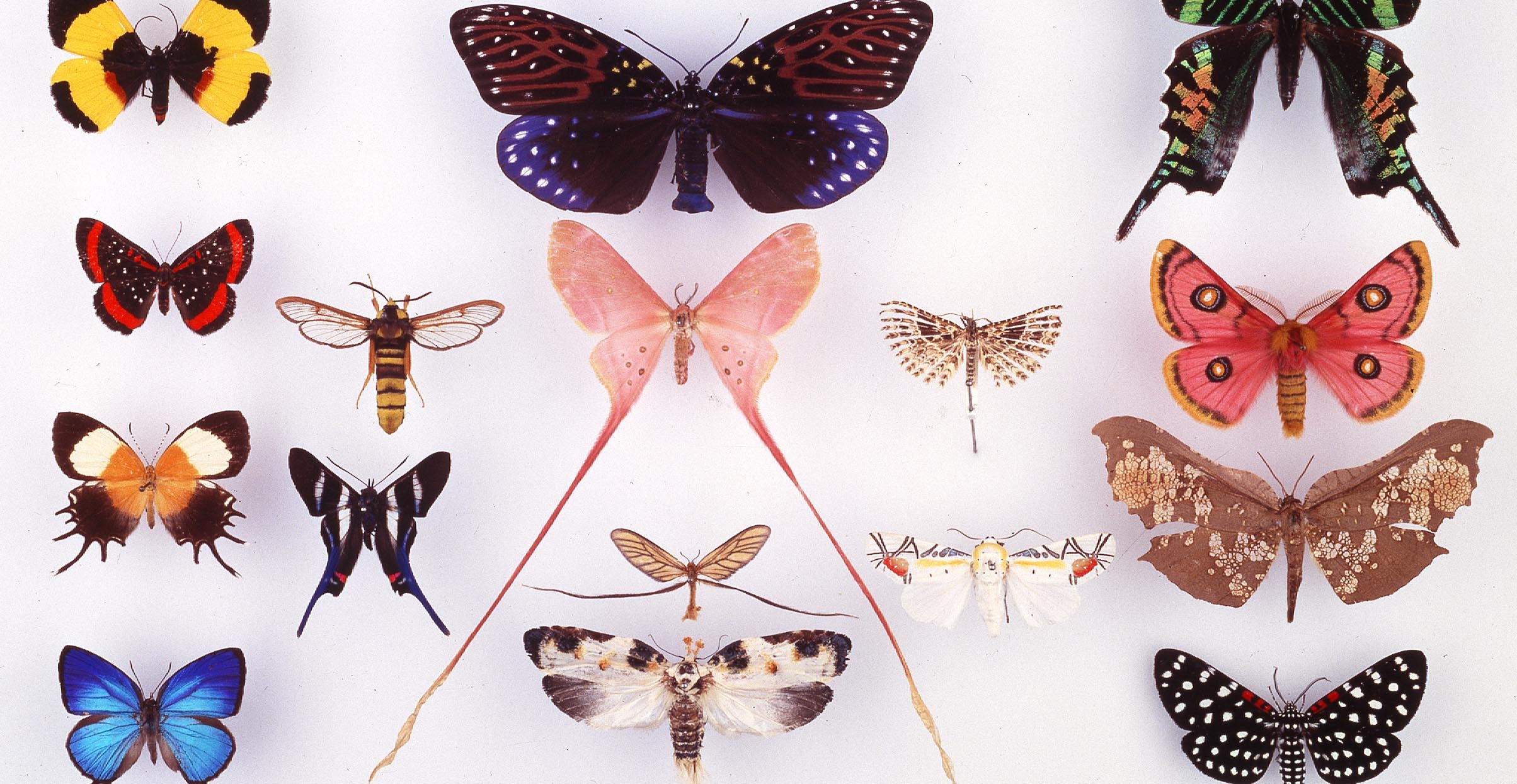


Join our community of planet fixers
Enter your email to get monthly tips on living sustainably as well as articles, events and information to help you become an advocate for our planet. We may occasionally include information about other parts of the Museum or third-party content from our corporate partners and other museums. We will not share your personal details with these third parties. You must be over the age of 13. Privacy notice.
Follow us on social media